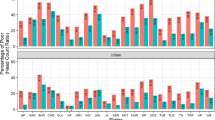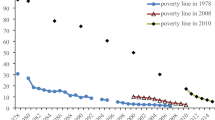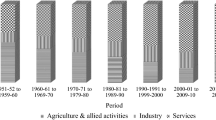Abstract
The relationship between growth and poverty is complex in Pakistan, where economic growth has not always been translated into poverty reduction. In the present work, three waves of a panel/longitudinal household survey, conducted between 2001 and 2010, were used to analyze poverty trajectories as well as the relationship between their patterns and economic growth. The findings from the panel survey reveal that more than half of the rural population remained in the state of poverty at least for one period. Poverty is transient in nature, as moving into and out of poverty is a common phenomenon in rural Pakistan. The high-growth period of 2001–2004 was not pro-poor, whereas the low-growth period of 2005–2010 was pro-poor despite the political and economic challenges. The findings reveal that policy interventions for the chronically poor may not be the same as those for the impoverished and transitory poor.
Résumé
La relation entre croissance et pauvreté est complexe au Pakistan, où croissance économique ne rime pas toujours avec réduction de la pauvreté. Nous avons utilisé trois vagues d’enquêtes auprès de ménages, menées entre 2001 et 2010, pour analyser les trajectoires de pauvreté ainsi que pour évaluer la relation entre les modèles de trajectoires de pauvreté et la croissance économique. Les résultats de l’enquête par panel révèlent que plus de la moitié de la population rurale est restée en situation de pauvreté au moins pendant un temps. La pauvreté est temporaire par nature, puisqu’il est courant d’entrer ou de sortir d’une situation de pauvreté en zone rurale au Pakistan. La période de forte croissance de 2001-2004 n’a pas profité aux personnes en situation de pauvreté, alors que la période de faible croissance qui a suivi (2005-2010) leur a profité en dépit des défis politiques et économiques. Les résultats révèlent que les politiques publiques en faveur des personnes en situation de pauvreté chronique peuvent ne pas être les mêmes que celles en faveur des personnes en situation d’appauvrissement ou de pauvreté temporaire.

Source Pakistan Economic Survey, various editions

Source Estimated from two waves (2001 and 2004) of panel micro datasets

Source Estimated from two waves (2004 and 2010) of panel micro dataset

SourceEstimated from two waves (2001 and 2010) of panel micro dataset

Similar content being viewed by others
Notes
The Planning Commission of Pakistan measured the official poverty line by using the Pakistan Integrated Household Survey (PIHS) 1998–1999 dataset, based on 2350 calories per adult per day. Basic non-food items were also adjusted for the poverty line, which was inflated over time by the CPI.
Share of Punjab in total population of Pakistan is 56%, followed by Sindh with its 25% share
The asset index variable ranges from 0 to 8, including eight assets that are washing machine, AC, TV, Telephone, computer, refrigerator, motorcycle, and car.
References
Arif, G., and F. Bilquees. 2007. Chronic and Transitory Poverty in Pakistan: Evidence from a Longitudinal Household Survey. The Pakistan Development Review 46 (2): 111–127.
Arif, G., and S. Farooq. 2014. Rural Poverty Dynamics in Pakistan: Evidence from Three Waves of the Panel Survey. The Pakistan Development Review 53 (2): 71–98.
Arif, G., et al. 2011. The Persistence and Transition of Rural Poverty in Pakistan: 1998–2004. Working Papers & Research Reports.
Baulch, B., and E. Masset. 2003. Do Monetary and Nonmonetary Indicators Tell the Same Story about Chronic Poverty? A Study of Vietnam in the 1990s. World Development 31 (3): 441–453.
Bruno, Michael, Martin Ravallion, and Lyn Squire. 1998. Equity and Growth in Developing Countries: Old and New Perspectives on the Policy Issues. In Income Distribution and High Growth, ed. Vito Tani and Ke-Young Chu. Cambridge, MA: MIT Press.
Chenery, Hollis, C.L.G. Montek Ahluwalia, John Duloy Bell, and Richard Jolly. 1974. Redistribution with Growth. New York: Oxford University Press.
Hossain, M., and A. Bayes. 2009. Rural Economy and Livelihoods: Insights from Bangladesh. Dhaka: AH Development Publishing House.
Hulme, D., et al. 2001. Chronic Poverty: Meanings and Analytical Frameworks. Chronic Poverty Research Centre Working Paper(2).
Jamal, H. 2014. Growth and Income Inequality Effects on Poverty: The Case of Pakistan (1988–2011).
Knowles, S. 2001. Inequality and Economic Growth: The Empirical Relationship Reconsidered in the Light of Comparable Data. Centre for Research in Economic Development and International Trade, CREDIT Research Paper Number 3, University of Nottingham.
Krishna, A. 2012. Characteristics and Patterns of Intergenerational Poverty Traps and Escapes in Rural North India. Development Policy Review 30 (5): 617–640.
Kurosaki, T. 2006. The Measurement of Transient Poverty: Theory and Application to Pakistan. The Journal of Economic Inequality 4 (3): 325–345.
Lohana, H.R. 2009. Poverty Dynamics in Rural Sindh, Pakistan. Chronic Poverty Research Centre Working Paper (157).
Mariotti, C., and V. Diwakar. 2016. Ensuring Escapes from Poverty are Sustained in Rural Ethiopia. CPAN, ODI. Produced as Leo Report 36.
Mellor, J.B. 1999. The Structure of Growth and Poverty Reduction. Washington, DC: (Mimeo) World Bank.
Miller, R., et al. 2011. Family Histories and Rural Inheritance in Kenya. CPRC Working Paper 220. Manchester: Chronic Poverty Research Centre (CPRC).
Nayab, Durr-e, and G. Arif. 2012. Pakistan Panel Household Survey Sample Size, Attrition and Socio-demographic Dynamics. Islamabad: Pakistan Institute of Development Economics.
Perotti, R. 1996. Growth, Income Distribution, and Democracy: What the Data Say. Journal of Economic Growth 1: 149–187.
Ravallion, M. 1995. Growth and Poverty: Evidence for Developing Countries in the 1990s. Economics Letters 48: 411–417.
Ravallion, M. 2002. Externalities in Rural Development: Evidence from China. Policy Research Working Paper, The World Bank, No. 2879.
Ravallion, M. 2004. Pro-poor Growth: A Primer. Policy Research Working Paper Series 3242. Washington, DC: The World Bank.
Ravallion, M., and S. Chen. 2003. Measuring Pro-poor Growth. Economics Letters 78 (1): 93–99.
Ravallion, M., and G. Datt. 1996. How Important to India’s Poor is the Sectoral Composition of Economic Growth? World Bank Economic Review 10: 1–25.
Ravallion, M., and J. Jalan. 2001. Household Income Dynamics in Rural China. Washington, DC: The World Bank.
Scott, L., et al. 2016. Ensuring Escapes from Poverty are Sustained in Uganda. CPAN, ODI. Produced as Leo Report 25.
Acknowledgements
The current paper is part of the detailed report entitled “Economic Growth and Dynamics of Rural Poverty: The Case of Pakistan (2000–2010),” presented at the Technical Workshop on “Economic Growth and Dynamics of Rural Poverty” hosted by the Chronic Poverty Report (CPR), June 19, 2017 London, UK. The authors are grateful to the Chronic Poverty Advisory Network, Andrew Shepherd (Director CPAN), and Vidya Diwakar (Senior Research Officer CPAN) for giving valuable feedback on the report.
Author information
Authors and Affiliations
Corresponding author
Additional information
Publisher’s Note
Springer Nature remains neutral with regard to jurisdictional claims in published maps and institutional affiliations.
Rights and permissions
About this article
Cite this article
Farooq, S., Ahmad, U. Economic Growth and Rural Poverty in Pakistan: A Panel Dataset Analysis. Eur J Dev Res 32, 1128–1150 (2020). https://doi.org/10.1057/s41287-020-00259-y
Published:
Issue Date:
DOI: https://doi.org/10.1057/s41287-020-00259-y




